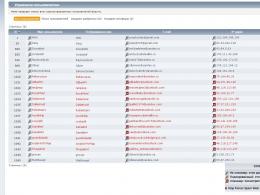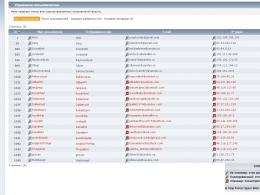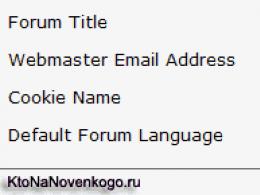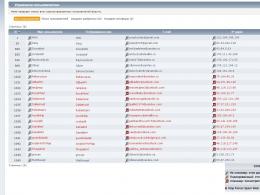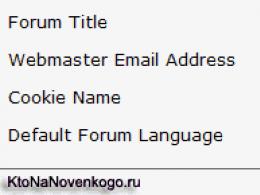Unable to install windows partition 1 of disk 0. Installing Windows on this disk is not possible
During the installation process, any modern versions Windows OS on your computer, the user may encounter the system message "Windows cannot be installed on partition 1 of disk 0". Typically, this situation occurs when the computer already has an installed OS (running on a modern table GPT partitions under UEFI hard disk), while the user tries to install on this disc another OS under MBR. In this article I will tell you what the message " Unable to install Windows on partition 1 of disk 0", what are the reasons for its appearance, and how to get rid of the message "Windows cannot be installed on partition 1 of disk 0" on your PC.
Before you can start using the hard drive, it must be partitioned. Information about the hard disk partition table is stored in the MBR (Master Boot Record), where, in addition to the partition table, there is a part of the executable code and a special signature. The MBR itself is usually located in the first sectors of the hard disk, and without reading the MBR code, further launch of the operating system is, in fact, impossible.
At the same time, the MBR boot record is capable of supporting disks with a capacity of no more than 2 Terabytes (2.2 TB), and no more than four main partitions.
But, as you know, nothing stands still, and the outdated BIOS has been replaced by new interface UEFI, including the improved GPT standard (English Guid Partition Table - GUID Partition Table). Now each partition on your disk is assigned a unique GUID, and the system for placing files on such a disk itself will be devoid of many MBR restrictions (including the mentioned disk size limits of 2.2 Terabytes). The number of possible partitions is also unlimited, while GPT works much faster, allows you to recover previously damaged information, and much more.

Causes of the message "Windows cannot be installed on partition 1 of disk 0"
Accordingly, if there is already a disk with GPT under UEFI, and the operating system is already installed on it, then when you try to install new version Windows from a disk or flash drive under an MBR disk, the system will respond with the already mentioned message "Windows cannot be installed on disk 0 partition 1".
At the same time, there are also examples of the opposite, when they try to install an OS under GPT on a disk under MBR. Then the system will indicate that it is not possible to install a new OS on the disk, since it already has an MBR partition table.
Accordingly, the conflict of installing the OS under MBR - GBT will be the cause of the error with the inability to install Windows OS in partition 1 of disk 0.

How to fix "Windows cannot be installed on partition 1 of disk 0" issue
So, how to fix the error "Windows cannot be installed on partition 1 of disk 0". There are two main ways:
- Delete all partitions on the disk, and then create them again underMBR. With this method, the data on the deleted disks will be lost, and a disk with an MBR partition table will be created.
To do this, click on "Disk Setup" when Windows installation, delete the hard disk partitions, and then re-create them (they will be created already under the MBR).

At the same time, it is worth considering that if you have a disk larger than 2.2 TB, then the system can again create a GPT table on the disk.
- An alternative, but more complex, option is using the utility to work with diskpart disks . To implement this option, boot from installation flash drive(or disk), select a language, click on the "Next" button. Then select "Install", then "I accept the terms of the agreement" - "Next" - "Full installation".
Then press Shift + F10 (for laptops Fn + Shift + F10), which will launch the command line. In it, type the following commands in sequence, remembering to press enter after each command:
diskpart
list disk(displays a list of disks)
select disk 0(instead of "0" there may be another number desired disk, if there is only one disk, then it is 0);
clean(clears the disk from other partitions)
convert mbr(transforms GPT disk to MBR)

After executing these commands, you can usually continue installing the OS already on a disk with an existing MBR table.
Conclusion
In the question of how to get rid of the message “Windows cannot be installed on partition 1 of disk 0”, you must proceed from an understanding of the MBR-GBT conflict, and install a new OS immediately under GBT, or clear existing disk partitions, create MBR, and only then install under MBR new OS. This will help to avoid the message I am considering, and install a new operating system on your PC without any problems.
In contact with
With the message " Windows installation to this disk is not possible" at the stage of selecting the operating system installation partition, you may encounter if not supported loading from the selected storage medium. The reason for such an obstacle is stated in the message of the installer.
reasons There may be several problems like this:
- worn out or damaged SATA cable;
- disabled hard disk controller in BIOS;
- malfunctions the data carrier itself;
- absence as part of the distribution Windows drivers AHCI;
- out of format BIOS - UEFI or Legacy - disk partition style - respectively, GPT and MBR.
Let's talk about the last two problems in more detail.
Problem with AHCI
The appearance at one time of the connection mode of the SATA-controller of storage media AHCI, which replaced the old IDE, entailed an additional requirement to the composition of the Windows distribution kit - the presence of the appropriate drivers. AHCI driver support is announced in OS versions starting with Vista.
But not always Windows 7 wants to be installed on a computer with active mode SATA AHCI controller. There are two exits - distribution change(AHCI drivers can be cut by pirate build packers) and AHCI switching to the old IDE mode. In the latter case, you need to enter the BIOS, find the SATA controller settings section (the sections may be called "Integrated Peripherals", "Storage Configuration", etc.) and change the preset AHCI to IDE. 
MBR to GPT conversion
Windows won't install if the drive has not the style sections:
- GPT, while the UEFI interface in the BIOS is disabled;
- MBR, whereas UEFI mode is active and Windows is installed from a bootable UEFI media.
The last case is the most common: it is faced by everyone who, either replaced motherboard to a new one with BIOS UEFI support, or connected to PC assembly HDD drives or SSD with MBR partitioning. There may also be two ways out of the situation:
- refuse from benefits of UEFI, disable this interface in the BIOS (switch to Legacy) and continue installing Windows on an MBR disk;
- convert it to GPT.
If there is no important data on the hard drive, transformation from MBR to GPT will be implemented automatically Windows installer. To do this, at the stage of choosing the OS installation location, you need to delete all existing partitions. 
And as a place of installation specify whole unoccupied space. 
Need to complete the process reinstalling windows, return to the old system and install this program. Or boot up with LiveDisk with AOMEI Partition Assistant included, if access to old Windows already impossible. Program developer - AOMEI company - provides the ability to create an emergency bootable media with your products on board. To create such media, you need to use another company product - AOMEI PE Builder. Also, AOMEI Partition Assistant, among other software for system specialists, is part of LiveDisk AdminPE.
To convert disk from MBR to GPT, follow the steps as in the screenshots below.



After converting the section style again launch Windows installation.
Convert GPT to MBR
If the question is reversed, for example, motherboard do not support BIOS UEFI, but the assembly of components included an HDD or SSD with GPT markup, there will be nothing left but convert it in the MBR. This can be done in the same ways as described above for the reverse process:
- through removal all partitions using the Windows installer, if there is no need for data stored on the disk;
- via programs AOMEI Partition Assistant.
To convert a disk from GPT to MBR, follow the same steps as in previous section article, with the only difference that this time we launch, respectively, the reverse operation. 
You may see this message when you install one of the new versions of Windows. Most often, the cause is a different version of this operating system that was installed earlier.
At first glance, the problem of incompatibility looks complicated, but you can try to solve it without the help of professionals. There are two ways to fix it - reformatting the disk or entering certain commands. The article presents both methods with a detailed explanation.
Causes
The reasons for the incompatibility of operating systems of the same developer lie in different ways organizing data on a hard drive in an outdated BIOS interface and a more advanced UEFI.
V BIOS hard disk (HDD) is marked before use. In its first sections is Master Boot Record (MBR) - "master boot record". Among other things, it has a table of sections of the railway. The system will not start until the MBR code is read. The "Master Boot Record" is designed to support hard drives smaller than 2.2 Tetrabytes (TB), which typically contain 4 primary partitions or less.
The more advanced and improved UEFI removes the 2.2 TB limit and the number of partitions that can be assigned their own GUIDs. They are stored in the GUID Partition Table - GPT, translated from English as "GUID Partition Table". Copies of GPT are located in different places on the disk, which makes GPT less vulnerable compared to MBR, where the partitioning data is stored in one place.
If Windows is installed on the computer under the GPT standard, and you are trying to install a version of Windows tied to the MBR standard, the same “Windows cannot be installed on partition 1 on disk 0” appears.
Correction

You can remove the obstacle and continue installing the desired version of the OS by reformatting or by introducing a sequence of instructions.
reformatting
Partitions are removed from the disk, and new ones are created under the MBR structure.
All data that is on the computer will be destroyed, so it is advisable to first copy valuable information to a USB flash drive.
Reformatting is fairly easy. Select "Disk Setup" when installing Windows, remove the GPT partitions, and then create new ones under the MBR standard.
Using the diskpart utility
This method is more difficult. You will need to enter the codes in a certain sequence, after which it will be possible to install Windows under the MBR table.
You should proceed as follows:
- run boot disk or a flash drive;
- define language;
- select “Install” in sequence, accept the terms of the user agreement, and go to the “Full installation” item.
Then you will need to press Shift+F10. If you are installing the OS on a laptop, then the keyboard shortcut will be - Fn + Shift + F10. You will see an input line.
Enter English words sequentially<в скобках даны пояснения>:
- diskpart-<управление разделами>;
- list disk -<вывод списка дисков, в случае единственного диска, выводится с номером 0>;
- select disk 0<обозначается раздел для последующих операций, если в компьютере больше одного диска, укажите нужный номер>;
- clean-<очистка>;
- convert mbr-<перевод из стандарта GPT в стандарт MBR>
- exit-<выйти>.
Then the work of installing Windows continues as usual with the finished MBR table.
Find out the type of partition on the disk

Since the problem occurs due to differences between MBR and GBT, you can find out in advance which standard is already installed before installing Windows. Then it will be possible to install desired version Windows immediately under GBT, or clean the hard drive, prepare the MBR, and then install a new system.
You can use the following commands to define the standard.
After pressing the combination Win + x and select "Command Prompt", "Command Prompt (Administrator)".
In the results you can see the GPT column, and if it is marked with *, then this is it, in otherwise you have an MBR.
Thus, the problem of incompatibility of Windows versions will be solved in advance, and the installation will go smoothly with a certain amount of luck.
Related videos
A friend brought me his laptop Lenovo and asked me to install on it Windows 10 instead of Windows 8. By the way, the “eight” has been on it since the moment of purchase in the store. This laptop has Bios UEFI. I already told you once, laptops with such a BIOS.
So, I inserted my bootable USB flash drive with Windows into this laptop. Then I set it in Bios so that the boot from the USB flash drive was successful. I'm going to install.
At first, everything goes as usual: 
I choose the largest partition on the hard disk in terms of volume, where I will install the system. And then I find that the “Next” button is not active. At the bottom I see a warning: “”. Click here" Show details”:
An error window appears: "": 
Now I will explain what this error means. And how can you still install Windows in this situation:
GPT(GUID Partition Table)- it new standard placement of partition tables on the hard drive. Most modern laptops that come pre-installed with Windows 8 or Windows 10 use this standard.
To install windows 10 on laptop gpt disk Bios UEFI from a bootable flash drive, one of the following conditions must be met:
1) either it was UEFI flash drive(created in a special way. For example, using the program Rufus)
2) or, if the flash drive is not UEFI, then you need to convert hard drive from GPT standard to legacy MBR standard
I had a normal bootable flash drive With operating system(not UEFI), and I did not want to redo it at all. Therefore, I decided to use the second option - convert laptop hard drive. This is done at the time of installing the OS using command line.
Important: during the conversion process, all data from hard drive will be removed! Even if your disk is divided into several partitions (for example, “ local disk C” and “Local Disk D”) – then all these partitions will be deleted! Therefore, if you, for example, have some important personal files on drive D, then it’s better to cancel the installation, then drop these files somewhere on a USB flash drive or external hard disk, and only then continue.
In my case, on Lenovo laptop was still hidden section with the rollback program to the “store state”. After converting the hard drive from GPT to MBR, it will also become inoperable. When I warned the owner of the laptop about this, he said that he was not going to return to Windows 8 - he asked me to put him either a "seven" or a "ten".
The instructions for installing Windows on a laptop given in the article are relevant for both Windows 10, and for Windows 7.
So, I told you about the reason for the error: “ Windows cannot be installed to this drive. Selected disk has GPT partition style". He also warned about the consequences converting hard disk from GPT to MBR. Now let's continue with our installation:
After encountering an error about the GPT partition style − calling the command line by pressing the keyboard shortcut Shift+F10(on my laptop I had to press Fn+Shift+F10):
In the black window that opens, type the command diskpart and press the key Enter on keyboard: 
Now you need to select the hard drive that we will convert. First find out his number. To do this, enter the command list disk and press the key Enter:
In my case, the system detected two disks. But it is clear from the volume that Disk 0 is the hard disk of a computer Disc 1- this is my personal flash drive from which I install in this moment Windows.
Naturally, we will work with Disk 0. Therefore, in command line write the following command: sel dis 0 and press the Enter key: 
Then we enter the command clean and press the Enter key. HDD will be completely cleared, including all files and partitions: 
Now enter the command and press the Enter key. Thus, we converted the disk to the MBR standard: 
After that, enter again exit and again press Enter: 
We return to our window with sections and click here “ Refresh". Then press the button " Further”:
We see the following window: 
We can immediately click “Next” and the Windows installation process will begin. Can we first create the number of partitions we need on the hard drive by clicking the “ Create”:
In any case, the process of installing Windows on a laptop should go on without problems: 
When installing Windows, it is quite rare, but still various errors occur. In most cases, they lead to the fact that the continuation of the installation becomes impossible. There are many reasons for such failures - from incorrectly created installation media to incompatibility of various components. In this article, we will talk about troubleshooting errors at the stage of selecting a disk or partition.
Let's take a closer look at the error itself. When it occurs, a link appears at the bottom of the disk selection window, clicking on which opens a hint indicating the reason.

Causes causing given error, just two. The first is the lack of free space on target drive or partition, and the second is related to the incompatibility of partition styles and firmware - BIOS or UEFI. Next, we'll figure out how to solve both of these problems.
Option 1: Not enough disk space
You can get into such a situation when trying to install the OS on a disk that was previously partitioned. access to software or system utilities we don’t have, but a tool “sewn” into the installation distribution kit will come to our rescue.

You can, of course, install "Windows" in another suitable partition, but in this case, an empty space will remain at the beginning of the disk. We will go the other way - we will delete all partitions by merging the space, and then we will create our volumes. Please note that all data will be deleted.
- Select the first volume in the list and open the disk settings.

- Click "Delete".

In the warning dialog, click OK.

- We repeat the steps with the rest of the sections, after which we get one large space.
- Now let's move on to partitioning.
If you do not need to partition the disk, then you can skip this step and go directly to installing Windows.
Click "Create".

- Set the required volume volume and click "Apply".

The installer will inform us that an additional system partition may be created. Agree by clicking OK.

- Now you can create one or more partitions, or maybe do it later with the help of special programs.
- Done, a volume of the size we need has appeared in the list, you can install Windows.

Option 2: Partition table
To date, there are two types of tables - MBR and GPT. One of their main differences is the support for the UEFI boot type. GPT has this feature, but MBR doesn't. There are several options for user actions in which installer errors occur.
- Trying to install a 32-bit system on a GPT disk.
- Installation from a flash drive containing a distribution kit with UEFI to an MBR disk.
- Installing from a distribution without UEFI support on GPT media.
As for the bit depth, everything is clear here: you need to find a disk with a 64-bit Windows version. Problems with incompatibility are solved either by converting formats, or by creating media that supports one or another type of download.
The article available at the link above describes only the option of installing a system without UEFI on a GPT disk. In the opposite situation, when we have a UEFI installer, and the disk contains an MBR table, all actions will be similar, except for one console command.
it needs to be replaced with

C BIOS settings also the opposite is true: for disks with MBR, you need to disable UEFI and AHCI mode.

Conclusion
Thus, we figured out the causes of problems with disks when installing Windows and found their solution. In order to avoid errors in the future, it is necessary to remember that on GPT disks you can install only a 64-bit system with UEFI support or create the same flash drive. Everything else is installed on the MBR, but only from non-UEFI media.

